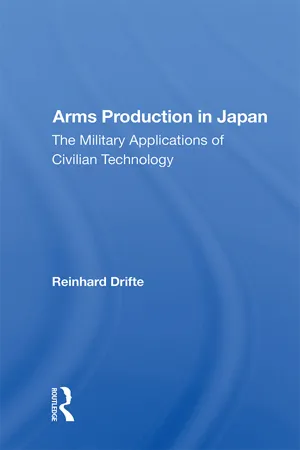
eBook - ePub
Arms Production In Japan
The Military Applications Of Civilian Technology
This is a test
- 150 pages
- English
- ePUB (mobile friendly)
- Available on iOS & Android
eBook - ePub
Book details
Book preview
Table of contents
Citations
About This Book
Although Japan's arms industry is still relatively small, significant political, economic, and technological developments indicate its growing importance and pave the way for Japan's increasing involvement in arms production. In this comprehensive study, Dr. Drifte examines both the domestic and international environments that are encouraging Japan
Frequently asked questions
At the moment all of our mobile-responsive ePub books are available to download via the app. Most of our PDFs are also available to download and we're working on making the final remaining ones downloadable now. Learn more here.
Both plans give you full access to the library and all of Perlego’s features. The only differences are the price and subscription period: With the annual plan you’ll save around 30% compared to 12 months on the monthly plan.
We are an online textbook subscription service, where you can get access to an entire online library for less than the price of a single book per month. With over 1 million books across 1000+ topics, we’ve got you covered! Learn more here.
Look out for the read-aloud symbol on your next book to see if you can listen to it. The read-aloud tool reads text aloud for you, highlighting the text as it is being read. You can pause it, speed it up and slow it down. Learn more here.
Yes, you can access Arms Production In Japan by Reinhard Drifte in PDF and/or ePUB format, as well as other popular books in Politics & International Relations & Arms Control. We have over one million books available in our catalogue for you to explore.
Information
1
Development and the Present Situation of Japan's Arms Production Capability
The New Beginning After the War
Arms production got off to a new start in Japan in 1947 when General Douglas MacArthur, who headed the U.S. occupation forces in Japan between 1945 and 1951, initiated operation Roll-Up, which brought to Japan U.S. weapons left in different Asian regions of conflict after the war in the Pacific The reason for collecting these weapons was a lack of funds to buy new equipment. These weapons were overhauled and repaired by Japanese workers, and MacArthur thus used the great pool of trained and cheap labor abundantly available in the country.1
The outbreak of the Korean War in 1950 proved to be the most important initial impetus to Japan's future arms production capability as well as to the country's whole economy. The United States used Japan as a large workshop to produce supplies for U.S. troops in Korea. In March 1952 the occupation authorities officially permitted arms production again, and on May 2, 1952, the United States placed the first order for complete weapons systems. In April 1952, 859 installations the United States had earmarked for reparations payments were returned to their Japanese owners, among them 314 aircraft factories, 131 military arsenals, 25 aircraft and weapons research centers and 18 shipyards. By May 1952 orders were placed for the manufacture of trench mortars and artillery pieces. In September the Japanese Government designated the weapons industry as a major "national policy" sector.2
The previous year, the Japan Ordnance Association (Nihon Heiki Kogyokai) was established, although it took its present name in 1953. According to figures from this association, Japan had produced arms amounting to 52 billion yen by 1962 ($144; $1 = 360 yen). In addition, between 1950 and 1962 Japan produced 10,000 vehicles amounting to 10 billion yen ($144 million), received 7 billion yen ($19 million) for the repair of weapons, 1 billion yen ($2.8 million) for the repair of aircraft and 7 billion yen ($19 million) for the repair of ships.3 According to Tomiyama, special procurements increased from $191 million in 1950 to $452 million in 1953. The Vietnam War led once again to a considerable increase of procurement orders. In aggregate the United States spent $5.6 billion in military orders in the 1950s. In 1960 military orders still continued at the level of $500 million per annum.4
When the procurement boom generated by the Korean War was over and munitions orders dropped, Japan's Ministry for Trade and Industry (MITI) decided to give financial aid to support Japanese production facilities. Altogether it gave 137 million yen ($380,000) to 24 factories, of which only 12 are still in production today.5 In July 1950 the National Police Reserve (NPR), the precursor of the Self-Defense Forces, was created and soon became the main customer for Japan's armsrelated production.
The Role of the Japanese-U.S. Security Treaty
Another important role in the rebirth of Japan's arms production capability was played by the Mutual Defense Assistance Agreement (MDAA) which was signed between Japan and the United States in March 1954, the year the NPR was transformed into the SDF. Although the agreement was seen by the U.S. Government as a means of support for building up the SDF, Japanese industries manag...
Table of contents
- Cover
- Half Title
- About the Book and Author
- Title
- Copyright
- Dedication
- Contents
- List of Tables
- Preface
- Introduction
- 1 Development and the Present Situation of Japan's Arms Production Capability
- 2 Research and Development
- 3 The Shipbuilding Industry
- 4 The Aircraft Industry
- 5 The Space and Missile Industry
- 6 Arms Exports
- 7 Conclusions
- Appendix A: The Exchange of Technology Agreement Between Japan and the United States
- Appendix B: Detailed Arrangements for the Transfer of Military Technologies
- Appendix C: Japanese Companies Working in Arms-Related Sectors
- Appendix D: Coproduction Authorized Between the United States and Japan Since January 1, 1976
- Bibliography
- Index